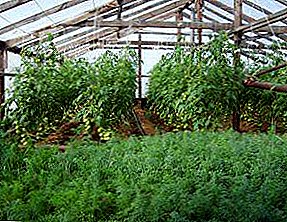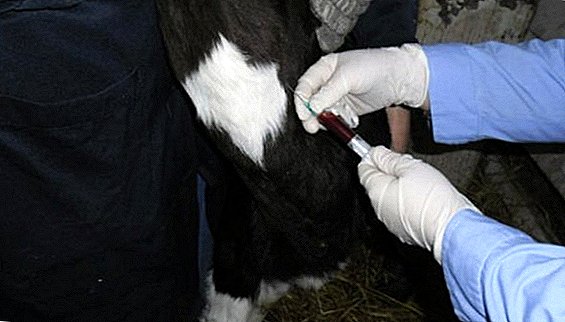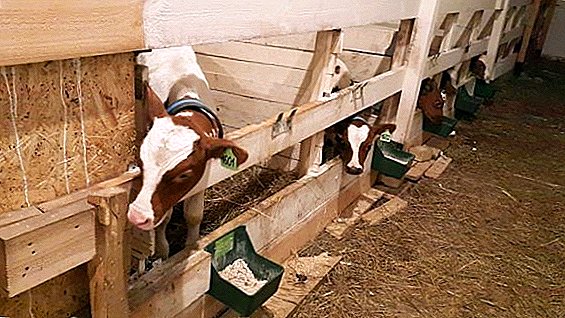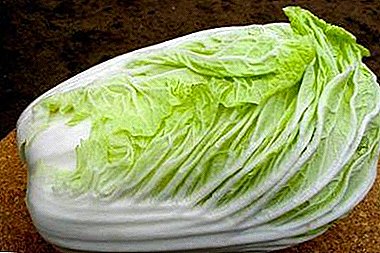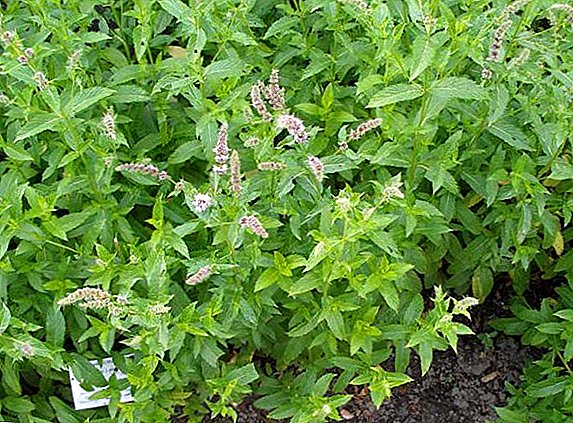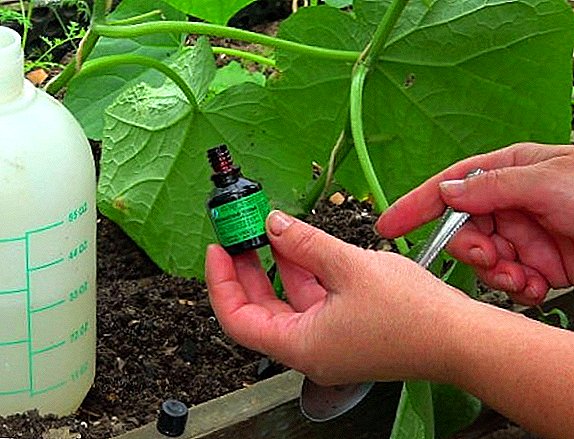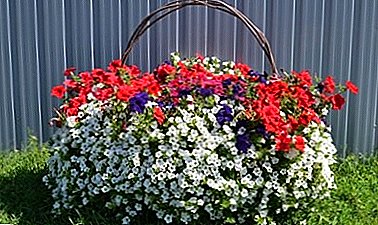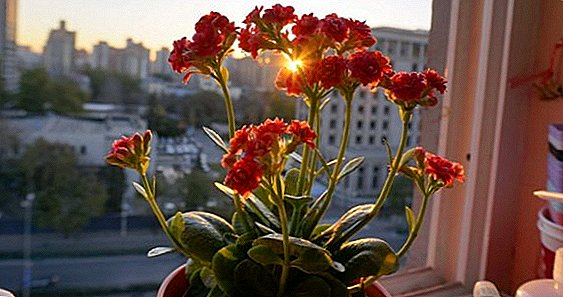 In terms of ease of growing and care, Kalanchoe is the most profitable indoor flower. However, even such an unpretentious plant refuses to bloom at home. Transplantation often helps to solve this problem. Why do I need to repot the flower and how to properly conduct this event, let's see.
In terms of ease of growing and care, Kalanchoe is the most profitable indoor flower. However, even such an unpretentious plant refuses to bloom at home. Transplantation often helps to solve this problem. Why do I need to repot the flower and how to properly conduct this event, let's see.
Why do I need to repot Kalanchoe
One of the points of care for Kalanchoe is its transfer to another pot. However, many growers do not know when and why they are holding this event. Indoor cultivars need replanting once a year.
Read the rules of care Kalanchoe at home.
In addition, the procedure is performed without fail:
- directly after purchase at a flower shop. The fact is that in the flower stalls for the active development of Kalanchoe use special substrate, designed to enhance the long flowering of the culture. This soil is not suitable for cultivation in the conditions of a flat flower;
- if the plant root system makes its way through the drainage holes in the tank;
- in cases of strong soil compactionwhen it becomes like a stone, as a result it is not able to pass moisture and nutrients to the roots.
 Kalanchoe refers to flowers with a fast growth rate, it actively grows both upwards with massive crown and downwards with abundant root processes. If you ignore the transplant activities, the root system of the plant will begin to rot and eventually may die.
Kalanchoe refers to flowers with a fast growth rate, it actively grows both upwards with massive crown and downwards with abundant root processes. If you ignore the transplant activities, the root system of the plant will begin to rot and eventually may die.When can the plant be repotted
The best time for a Kalanchoe transplant is considered to be spring, namely April-May. To carry out activities should be immediately after the plant has faded. In order for the plant to fully develop, the flowering phase grows and there is enough flow, it is sufficient to replant it once a year.
Important! If the culture was given the right care, then the end of flowering comes exactly in the period April-May. In case of non-observance of the basic rules, the flower may never enter the flowering phase. Then, when transplanting need to focus on the spring.
Preparing for a transplant
After flowering, it's time to take care of transplanting Kalanchoe into a new container. In order for the flower to quickly take root in a new place, it is necessary to choose a high-quality substrate. The perennial prefers light, nutritious soils, which pass moisture and air well and also have acidity in the range of pH 5.5-7.  Substrate for planting can be bought at flower shops or made independently of the following components:
Substrate for planting can be bought at flower shops or made independently of the following components:
- sod land - part 1;
- leaf soil - 1 part;
- humus - 1 part;
- river fine sand - 1 part.
Find out what are the diseases and pests of Kalanchoe.
Household soil mixture must be disinfected without fail in any way possible:
- ignite for 15-20 minutes in the oven at + 180 ° С;
- shed with boiling water or a weak solution of potassium permanganate, dry well;
- freeze for one night in the freezer.
 Before planting, the flower container must be sterilized - wash thoroughly with soapy water, rinse with boiling water or rinse with potassium permanganate solution, wipe dry with a clean towel. Such treatment will prevent bacteria, pathogens and fungi from entering the soil.
Before planting, the flower container must be sterilized - wash thoroughly with soapy water, rinse with boiling water or rinse with potassium permanganate solution, wipe dry with a clean towel. Such treatment will prevent bacteria, pathogens and fungi from entering the soil.Did you know? In the world there are more than two hundred varieties of Kalanchoe, with 58 of them used in the medical field. The juice from the leaves of the plant is used in dentistry, gynecology, surgery, as a wound healing, antibacterial and anti-inflammatory agent.
Step-by-step guide of Kalanchoe home transplant
Proper implementation of the procedure of transplantation of Kalanchoe will serve as a guarantee of its further full and high-quality development.
After the purchase
The plant is recommended to replant without fail after its purchase or in cases where it was presented. Changing the pot and the substrate will allow the flower to adapt more easily and quickly.  Technology replanting purchased culture has some features:
Technology replanting purchased culture has some features:
- Prepare a new container, which is 1.5-2 cm in diameter more than the old one.
- At the bottom of the pot is lined with a layer of drainage (about 2 cm), which is suitable clay, pebbles.
- The container is filled with substrate for 2/3 parts.
- From the old pot carefully using the method of transshipment pull the plant. They clean the root system of the soil, conduct a visual inspection of the root system - the old, diseased, dry, damaged processes are removed, the sections of the sections are treated with crushed activated carbon.
- The prepared plant is placed in a new pot, straighten the roots, sprinkled with a layer of soil at 1-3 cm.
- The surface of the soil carefully watered. After the moisture is absorbed into the ground fill up a small amount of substrate.
After transplantation, a container with a flower is placed in a permanent habitat.
During flowering
During the flowering period, it is not recommended to disturb the plant, since the flowering Kalanchoe directs all its strength to the formation of flowers, and transplanting for it during this period is a strong stress. An exception can be considered replanting culture after its acquisition.
Important! Experts advise that all manipulations associated with transplanting a plant be postponed to the spring period, when it completely discards all flowers. Until then, a quality care flower should be organized.
At the same time, the process is carried out very carefully and carefully, using the method of transferring a plant, trying to disturb the root system as little as possible. The process of transplantation in a similar case is carried out similarly as in the previous paragraph. 
Planting several Kalanchoe in one pot
To save space, planting several Kalanchoe into one container is allowed, and the plants may be of different subspecies. But it should be remembered that it is impossible to combine flowering varieties of crops with viviparous. To create a flower arrangement, you should stock up with a rather wide, but not deep ceramic pot.
Important! It is recommended to plant no more than three plants in one tank.
The transplant process itself is based on the following steps:
- A drainage layer 2-3 cm high, which will provide good moisture and air permeability, falls asleep into the container.
- On top of the drainage poured the prepared substrate.
- Perennials are planted in the soil at a distance of several centimeters from each other. It is impossible to plant Kalanchoe too closely, otherwise in the process of growth a strong plant will crowd out a weak one. In addition, at close proximity there may be a risk of developing mold, rot, pathogenic bacteria.
- The flowers are sprinkled with the remaining soil, the soil is abundantly moistened.

Peculiarities of care after transplantation
Kalanchoe is one of the most unpretentious and easy-to-care room flowers, but after transplanting it, it should organize comfortable conditions that will help the plant to acclimatize more quickly and painlessly.
Location and conditions of detention
Perennial prefers a well-lit place, which is reliably protected from direct sunlight and drafts. The optimum location of the culture is the south-eastern or eastern side of the apartment. In the summer it is recommended to install a pot of Kalanchoe in a shaded place. With prolonged exposure to the sun's rays, the flower is able to change the color of the foliage, and can also get burned.
We recommend that you find out why Kalanchoe does not bloom.
In the room where the culture is located, in the summertime it is recommended to adhere to stable temperature indices of + 23 ... + 25 ° С, in winter it is enough to maintain the temperature at + 12 ... + 16 ° С. Despite the fact that the plant normally tolerates short-term drought, it should not be placed near batteries, heating devices. Also it is necessary to protect the flower from high humidity, which can cause stagnant moisture in the soil and, as a result, rotting of the root system. 
Watering
Kalanchoe prefers moderate but regular watering. In the summer season, the flower should be moistened 1 time in 7-10 days. In winter, irrigation activities should be carried out even less often - once every two weeks. Experts advise to practice watering under the root, since the ingress of moisture on the foliage and stem can lead to their rotting.
Important! Kalanchoe leaves have the ability to accumulate moisture, so the flower can do without watering for some time. In this case, much more dangerous for the plant is considered excessive moisture, which contributes to the rotting of the root processes and the death of the entire bush.
To moisten the culture you need to use separated, soft water at room temperature. When watering, the water must completely pass through the soil and appear in the pan from where it needs to be drained.
Fertilization period
Feeding perennials should be after he has fully completed the acclimatization process after transplantation. As feedings you can use minerals or organic matter, which should be added in turn. Fertilization must be done once every 30 days. The flower responds well to complex fertilizers for cacti and succulents, for example, "Stimovit". 
Typical mistakes florist when transplanting
During the transplantation of Kalanchoe, inexperienced growers make a series of mistakes that have a negative impact on its further growth and development:
- The use of universal soil. Often for transplanting Kalanchoe flower growers apply universal soil mixtures for indoor plants, forgetting that the culture is a representative of succulents. For planting perennial should choose a less nutritious mixture, specially designed for cacti.
- Incorrect capacity. When a flower is transplanted, wide and deep pots are often used. However, this container is categorically not suitable for Kalanchoe, because it inhibits the growth of foliage and stem, activates the active growth of the root system, as a result of which it impedes the timely flowering of the crop. A new pot should be only 2-3 cm more than the previous one.
- Active feeding. Many flower growers and strive to feed the plant directly after transplantation. But this should not be done, it is necessary to provide the flower with comfortable conditions, allow time for adaptation and only then apply fertilizer.
- Change the appearance of the flower. Often after perennial transplanting its leaves begin to turn yellow and wither. The cause may be damage to the root system during a transplant. This phenomenon is considered normal, as the flower, in any case, needs time to adapt, and root shoots need time to get used to the new capacity and new soil volume.
Did you know? Surprisingly, in the regions that are considered the birthplace of Kalanchoe - South America and South Africa, the medicinal properties of the culture were not suspected for many millennia. As a medicine, this flower was studied by Ukrainian scientists in the 70s of the last century.Replanting Kalanchoe is not difficult, even for those fans of indoor plants, for whom this process is new. The main thing is to follow the basic rules of planting the plant and to organize for it a quality follow-up care, which consists in regular moistening and dressing.
Video: Kalanchoe Transplant




